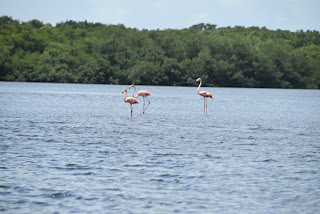Just seven miles off the coast of Venezuela, Trinidad and Tobago is one of the wealthiest and most developed nations in the Caribbean with a population of 1.4 million people. It is the 5th largest exporter of liquified petroleum gas. Also, asphalt is exported to the United States. We docked in Port of Spain, the capital city.
Just south of the city lies the Caroni Bird Sanctuary, the protected roosting site of the scarlet ibis, the national bird. Bird watchers flock to these islands which house over 450 species of birds. On our tour to the sanctuary we travelled through mangroves in a flat bottomed boat with an excellent guide.
 We saw a variety of birds, the crabs they eat, huge termite nests, and a boa contrictor. The red ibis was most visible flying overhead against the blue sky, although it could also be seen on the mangrove branches.
We saw a variety of birds, the crabs they eat, huge termite nests, and a boa contrictor. The red ibis was most visible flying overhead against the blue sky, although it could also be seen on the mangrove branches. The little blue heron and night heron were well hidden in the shadows. Tiny crabs climb up the aerial roots of the mangroves. The boa constrictor was curled up in a tree.
The little blue heron and night heron were well hidden in the shadows. Tiny crabs climb up the aerial roots of the mangroves. The boa constrictor was curled up in a tree.There were lots of flamingos feeding on the mud flats. Our guide said that they came two years ago fom South America and are now native.
Arriving back at the port, we were hot and thirsty so we went in search of cold beer. we walked to Independence Square with a local who suggested this restaurant - a little local colour.






No comments:
Post a Comment